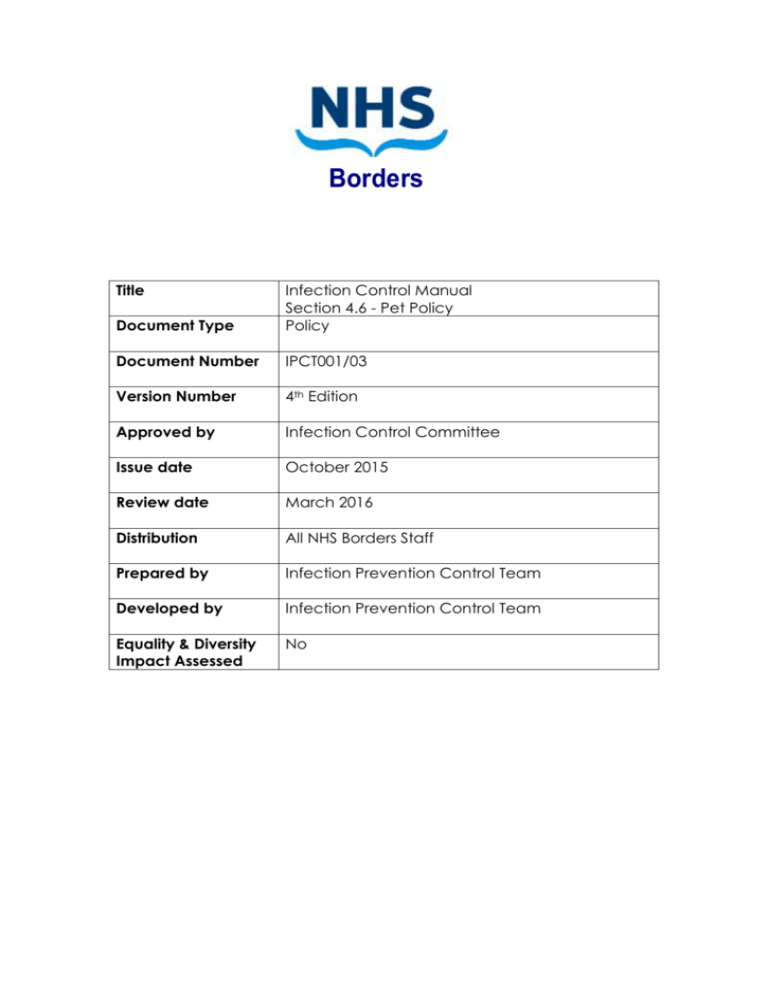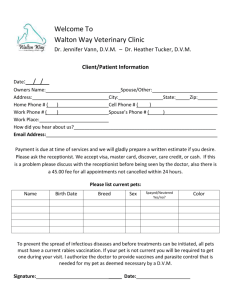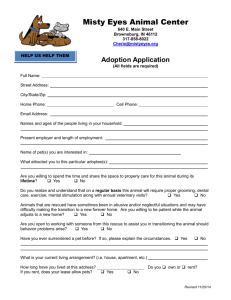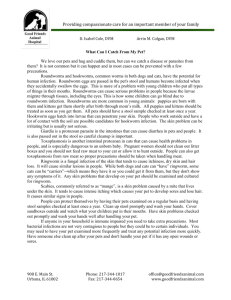46 Pet Policy CY Oct 15
advertisement

Borders Title Document Type Infection Control Manual Section 4.6 - Pet Policy Policy Document Number IPCT001/03 Version Number 4th Edition Approved by Infection Control Committee Issue date October 2015 Review date March 2016 Distribution All NHS Borders Staff Prepared by Infection Prevention Control Team Developed by Infection Prevention Control Team Equality & Diversity Impact Assessed No 4.6 PET POLICY Aim: Health hazards due to pets/animals are minimised by the adoption of appropriate control measures 1. Introduction The value of pet therapy is widely accepted as a powerful aid to stimulation and communication, pets can also enhance the quality of life of the elderly or those with chronic disease. It is well documented that diseases can be acquired from a variety of normal domestic pets. These policy guidelines will help reduce the risks of animal-borne or animal vector infection to staff, patients and visitors. 2. Standards Resident or visiting (except guide dogs) animals must be approved and advice sought from NHS Borders Infection Prevention Control Team/Health Protection Nurse Specialist (Infection Control for the independent sector) and the appropriate Clinical Service Manager/Clinical Development Manager. When considering pet therapy it is important to acknowledge that not all people are comfortable with animals, and the responsibility for keeping pets is not to be undertaken lightly. Consideration should also be given that some staff and patients may have an allergy to animals. Health and Safety pertaining to animals in the clinical setting must also be addressed before the animals are introduced into the area, contact NHS Borders Health and Safety Advisor. Funding for the care of pets (including veterinary fees) must be identified. Breeding of animals is not permitted and resident pets such as cats and dogs should be neutered. It is advised that tropical fish are not permitted. Pets within the In-patient areas of the Borders General Hospital or other High Risk areas will not normally be permitted. Please seek advice from the Infection Prevention & Control Team. IPCT001/03 Issue Date: October 2013 Review Date: October 2015 UNCONTROLLED WHEN PRINTED 2 3. Responsible Person A named member of staff must be designated by the Charge Nurse as the person responsible for the welfare of the animal. This includes feeding, grooming and health care of pet(s). A register of pets and the person responsible for their welfare should be kept by the Head of Service or a designated person nominated by the Head of Service. 4. Veterinary Advice The responsible person must make initial contact with a veterinary surgeon (preferably local) to receive advice on general care, diet, immunisation, de-worming, dealing with fleas / mites etc, and, if appropriate, screening. Veterinary surgeons are very interested in health promotion. [Note: this is with the exception of fish]. The responsible person should keep a record of vaccinations and/ or treatments received, including programmes of disinfestation and de-worming. 5. Pet Care Staff must wear personal protective equipment i.e. disposable gloves and apron when dealing with pets or their equipment. Pets should be fed in a non-patient area (with the exception of fish and caged birds). Food bowls, can opener and utensils should be washed immediately after use in warm water and detergent using a disposable cloth / paper towel then dried thoroughly with a paper towel. They must be washed and kept separate from patients’ crockery and cutlery. Can openers used for pet foods should never be used for opening containers of food destined for human consumption. Litter tray (if needed) must be kept in a non-patient area. Proprietary litter should be used and changed daily by a member of staff designated the responsible person. Disposable gloves and aprons must be worn and hands washed on completion of task. When necessary, litter trays should be washed out of doors. Pregnant staff must not handle litter trays. IPCT001/03 Issue Date: October 2013 Review Date: October 2015 UNCONTROLLED WHEN PRINTED 3 Litter, pet food, can opener and utensils should be stored in a designated cupboard in a non-patient area. Open cans must be resealed using a plastic lid. The responsible person should ensure that the pets bedding is kept clean to reduce the risk of infection. Pets are not permitted to sleep on patients’ beds. Cats should wear an identification collar (stating ward, hostel etc. of residence). 6. Hand Hygiene All staff and patients must thoroughly wash their hands with soap and water after handling an animal or any of its equipment, food or bedding. Hand washing is particularly important after contact with tropical fish or with fish tank water. 7. Therapeutic pet schemes The senior member of nursing staff on duty at the time of the Therapeutic pet visit must ensure that her/his ward is part of the current NHSB approved scheme before allowing the pet onto the ward to have patient contact. They must also ensure that good hand hygiene and infection control principles are adhered to. Pets must not be brought into ward areas such as those within Borders General Hospital. Furthermore, it is generally preferred for pets to be met within communal patient areas such as the day rooms; if further advice is required, please contact a member of the Infection Prevention Control Team. Please also refer to the NHSB Therapeutic pet policy IPCT001/03 Issue Date: October 2013 Review Date: October 2015 UNCONTROLLED WHEN PRINTED 4






